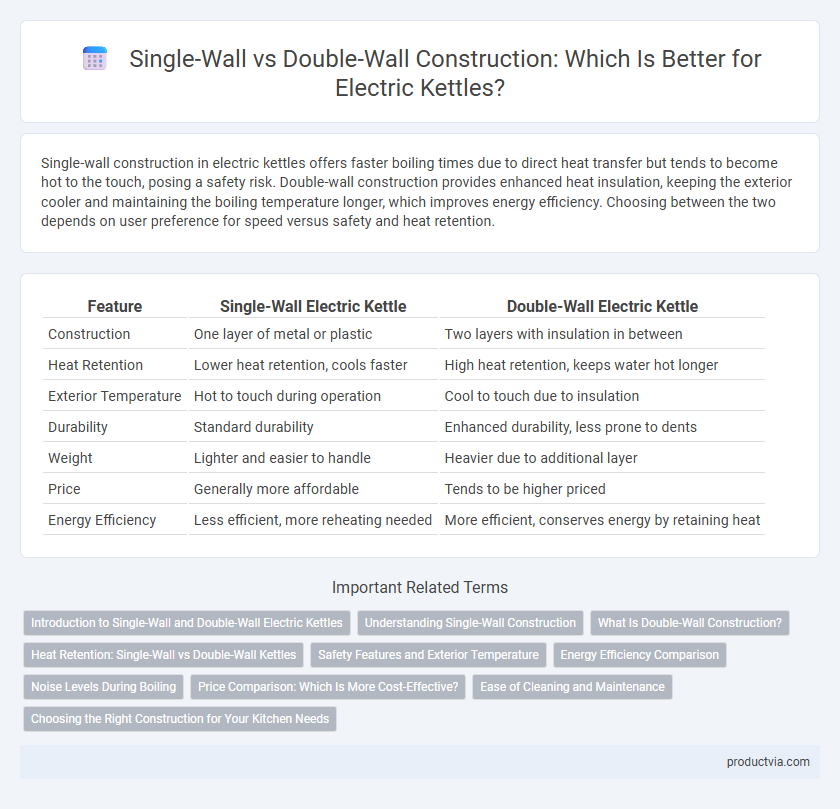Single-wall construction in electric kettles offers faster boiling times due to direct heat transfer but tends to become hot to the touch, posing a safety risk. Double-wall construction provides enhanced heat insulation, keeping the exterior cooler and maintaining the boiling temperature longer, which improves energy efficiency. Choosing between the two depends on user preference for speed versus safety and heat retention.
Table of Comparison
| Feature | Single-Wall Electric Kettle | Double-Wall Electric Kettle |
|---|---|---|
| Construction | One layer of metal or plastic | Two layers with insulation in between |
| Heat Retention | Lower heat retention, cools faster | High heat retention, keeps water hot longer |
| Exterior Temperature | Hot to touch during operation | Cool to touch due to insulation |
| Durability | Standard durability | Enhanced durability, less prone to dents |
| Weight | Lighter and easier to handle | Heavier due to additional layer |
| Price | Generally more affordable | Tends to be higher priced |
| Energy Efficiency | Less efficient, more reheating needed | More efficient, conserves energy by retaining heat |
Introduction to Single-Wall and Double-Wall Electric Kettles
Single-wall electric kettles feature a single layer of metal that heats water quickly but transfers heat to the exterior, making the surface hot to touch. Double-wall electric kettles have an insulating air gap or layer between two walls, keeping the exterior cooler and improving heat retention. Choosing between them depends on priorities like heating speed, safety, and thermal insulation efficiency.
Understanding Single-Wall Construction
Single-wall construction in electric kettles features a single layer of metal, typically stainless steel, which allows for faster heating and a more lightweight design. This type of construction offers direct heat transfer without insulation, resulting in quicker boiling times but increased external heat and risk of burns. Single-wall kettles are often favored for their simplicity and efficiency in heating water rapidly.
What Is Double-Wall Construction?
Double-wall construction in electric kettles involves two layers of material with an insulating air gap between them, enhancing heat retention and preventing external surfaces from becoming too hot. This design improves energy efficiency by keeping water hotter for longer compared to single-wall kettles. Double-wall kettles also offer safer handling by reducing the risk of burns and condensation on the outside.
Heat Retention: Single-Wall vs Double-Wall Kettles
Single-wall electric kettles heat water quickly but lose heat rapidly due to the thin metal exterior, resulting in poor heat retention. Double-wall kettles feature an insulated inner chamber surrounded by an outer shell, significantly reducing heat loss and maintaining water temperature longer. This double-wall design enhances energy efficiency and keeps water hot for extended periods without reheating.
Safety Features and Exterior Temperature
Single-wall electric kettles usually have a hotter exterior surface, increasing the risk of burns, while double-wall construction incorporates an insulated outer layer to keep the exterior cooler and enhance user safety. Double-wall kettles excel in maintaining a safe temperature for handling soon after boiling, making them ideal for households with children or elderly users. Safety features tied to double-wall designs often include heat-resistant handles and bases, reducing accidental burns and improving overall usability.
Energy Efficiency Comparison
Single-wall electric kettles heat water faster due to direct contact between the heating element and water, resulting in higher energy efficiency during boiling. Double-wall construction provides better insulation, reducing heat loss and keeping water warm longer, which saves energy over time by minimizing reheating frequency. Choosing between them depends on whether immediate boiling speed or sustained heat retention is the priority for energy savings.
Noise Levels During Boiling
Single-wall electric kettles typically produce higher noise levels during boiling due to the lack of insulation, causing sound to escape more easily. Double-wall kettles feature an insulated layer that reduces noise by dampening vibrations and trapping sound within the kettle. Consequently, double-wall construction is favored for quieter operation in household or office environments.
Price Comparison: Which Is More Cost-Effective?
Single-wall electric kettles generally offer a more cost-effective option, priced lower due to simpler materials and manufacturing processes. Double-wall kettles, featuring insulation between layers, command higher prices but provide superior heat retention and cooler outer surfaces. For budget-conscious buyers, single-wall models present the best initial investment, while double-wall versions justify their premium with energy savings over time.
Ease of Cleaning and Maintenance
Single-wall electric kettles feature a simple design with fewer components, making them easier to clean and maintain due to direct access to the inner surface. Double-wall kettles, while offering better heat retention and exterior coolness, tend to have more intricate assemblies that can trap moisture and limescale, complicating thorough cleaning. Choosing single-wall construction generally reduces maintenance time and prevents buildup issues common in double-wall models.
Choosing the Right Construction for Your Kitchen Needs
Single-wall electric kettles offer rapid boiling and lightweight design, ideal for quick use and easy handling, but they may transfer heat to the exterior, posing a safety concern. Double-wall construction provides enhanced heat insulation, keeping the outer surface cooler and preserving water temperature longer, which is beneficial for safety and energy efficiency. Selecting the right construction depends on prioritizing either speed and portability (single-wall) or safety and thermal retention (double-wall) based on your kitchen environment and lifestyle.
Single-wall construction vs double-wall construction for electric kettles Infographic

 productvia.com
productvia.com